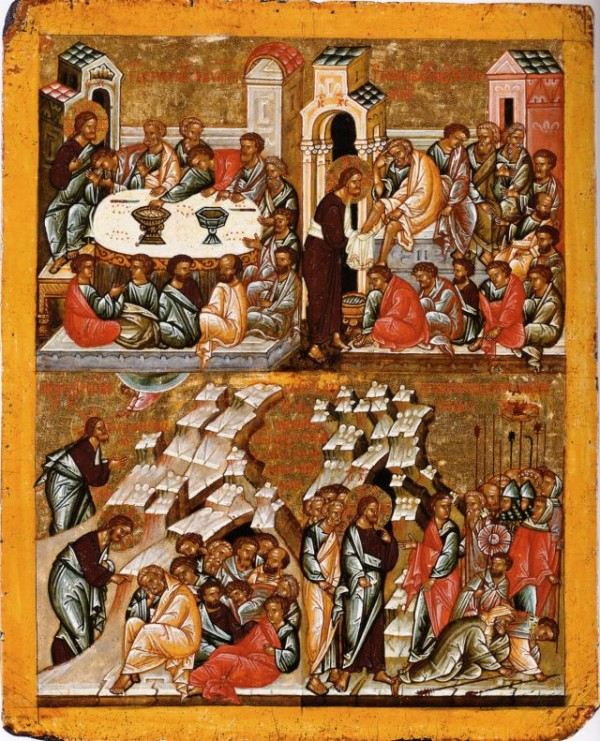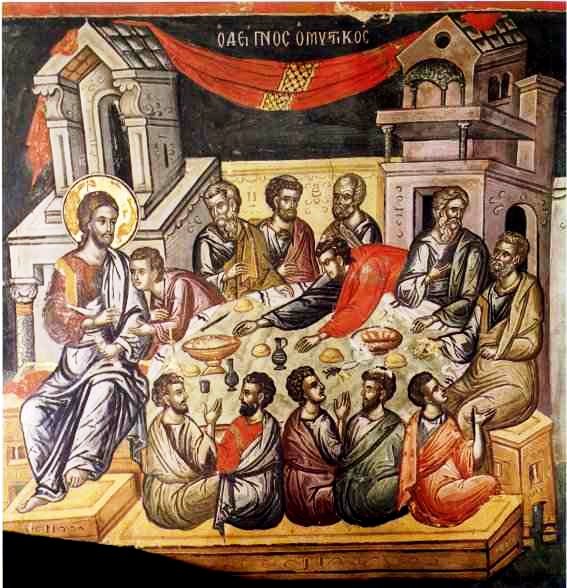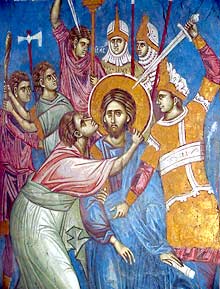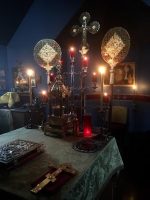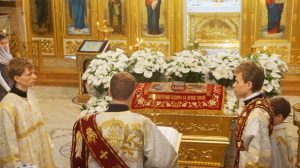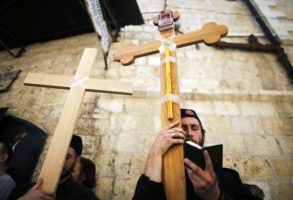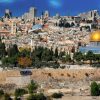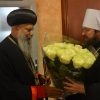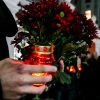Each of these events can be found in icons, and especially on church walls as part of the iconostasis, but the 15th Century Russian icon here groups the four events together.
The Last Supper
Also called the Mystical Supper, it was in the Upper Room sharing the Passover meal with the Twelve that Jesus gave a radically new meaning to the food and drink of the sacred meal. He identified Himself with the bread and wine: “Take, eat; this is my Body. Drink of it all of you; for this is my Blood of the New Covenant”(Matthew 26:26-28). Christians have come to understand that this was the institution of the Eucharist: whereby earthly food – bread and wine – becomes our gift of life, the Body and Blood of Christ.
Scenes of the Mystical Supper usually depict the event in a straight-forward manner, as described in the Gospels: the Twelve are seated around the table; John rests on Jesus’ bosom; and Judas dips his hand in the dish, revealing him to be Christ’s traitor.
The Foot-Washing of the Apostles
After the meal, Christ washed the feet of the Apostles. Where the Mystical Supper revealed His divine Son-ship and authority, offering Himself as Communion and life. By washing the feet of His disciples, He manifested His perfect love and revealed His profound humility.
Again, the scene of the foot-washing is depicted as described by the Gospels. When Peter, shown being the first to have his feet washed, objected to His Lord’s humility, Jesus replied that if He did not wash His feet then Peter had no communion with Him. Peter retorted: “Lord, not my feet only, but also my hands and my head,” and this is how he is shown in icons of the scene, hand raised to his head.
In the four-part icon at the top of this post, there is an interesting detail: the Apostle John appears to be pointing an accusatory finger towards Judas, who betrayed Christ.
Prayer in Gethsemane
Later that night, another significant event leading up to Jesus’ passion occurred: the prayer of Jesus in the Garden of Gethsemane (Matthew 26:36-46; Mark 14:32-42; Luke 22:39-46).
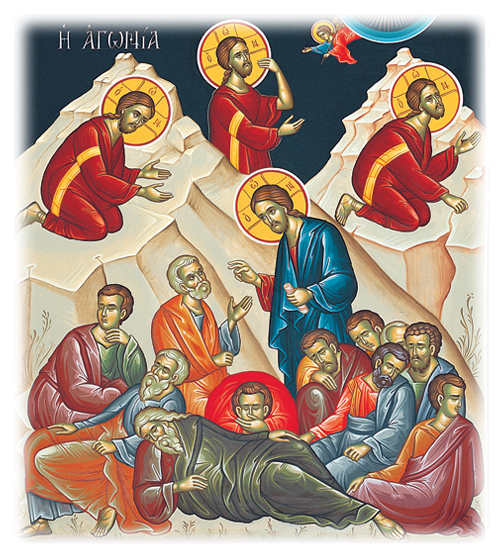 The moving events in the Garden of Gethsemane dramatically and poignantly disclosed the human nature of Christ. The sacrifice He was to endure for the salvation of the world was imminent. Instinctively, as man He sought to escape it. He found Himself in a moment of decision. In His agony He prayed to His Father, “Abba, Father, all things are possible to thee; remove this cup from me; yet not what I will, but what thou wilt” (Mark 14:36).
The moving events in the Garden of Gethsemane dramatically and poignantly disclosed the human nature of Christ. The sacrifice He was to endure for the salvation of the world was imminent. Instinctively, as man He sought to escape it. He found Himself in a moment of decision. In His agony He prayed to His Father, “Abba, Father, all things are possible to thee; remove this cup from me; yet not what I will, but what thou wilt” (Mark 14:36).
His prayer revealed the depths of His agony and sorrow. The fresco shown here has the Greek inscription for the event: “Agonia“.
Near Christ, the Twelve Apostles lay sleeping, unable to stay awake despite their Lord’s requests. Staying watchful for the Lord is a strong theme throughout Holy Week: Behold, the Bridegroom comes at midnight, and blessed is the servant whom He shall find watching, but unworthy is the servant whom He shall find heedless. (from the Bridegroom Matins of Holy Week)
The Betrayal and Arrest of Jesus
The beginning of Christ’s humiliation, and final crucifixion begins with His betrayal by one of Jesus’ own disciples: one of the Twelve. Judas’ sin is greater because there is no repentance, but nevertheless at this point, amid the flurry of steel and soldiers, the Gospels record that all His disciples abandon Jesus at this point, and run away. The only Apostle to follow Jesus (though discreetly) during His trial is Peter, who denies knowing His Saviour three times and is brought to bitter weeping for his own betrayal.
As all Jesus’ disciples temporarily abandoned Him during the arrest, it is usual for images of this scene to show Christ not looking at Judas, but directly out towards us.
+
When the glorious disciples were enlightened at the washing of their feet before the supper, the impious Judas was darkened by the disease of avarice, and to the lawless judges he betrayed You, the Righteous Judge. Behold, this man because of avarice hanged himself. Flee from the insatiable desire which dared such things against the Master! O Lord Who deals righteously with all, glory to You!
(Troparion for Holy Thursday)












